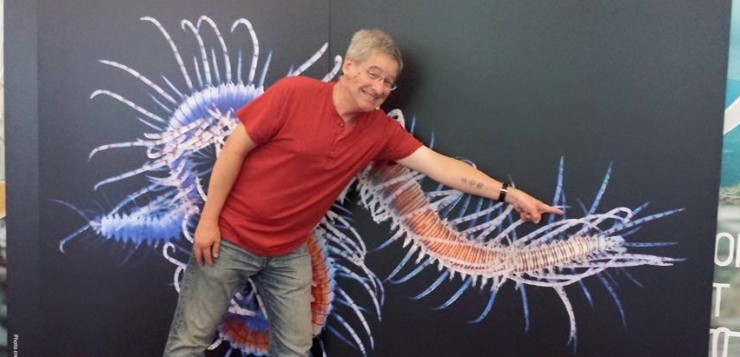DAVID ALONSO
My question is about abduction. Do you think there are different degrees of correctness of our abductive reasoning leading to the elaboration of explanatory hypothesis?

If your answer is yes, then I would expect that refining our abductive reasoning would lead to congruent explanatory hypothesis. In other words, do you see any problem in admitting that congruence is a signature of “being on the good track”, this is, as a way of increasing our belief in our explanatory ideas, even in the absence of test evidence, during the never-ending process of refining our abductive reasoning by way of including more and more observed evidence/data? Do you think that abduction is an inter-subjective scientific process while obtaining test evidence support for our theories becomes by way of induction becomes rather objective?
First, to say that a hypothesis is correct can have two different meanings. On the one hand, I could say my hypothesis is correct on the basis of the premises is used to infer the hypothesis. But more importantly, I should say my hypothesis is correct as a consequence of testing it.
To say we ‘refine’ a hypothesis means we have modified the hypothesis in some way, perhaps improving it or making it more clear as an explanatory device. I assume that your reference to ‘congruence’ means the similarities of phylogenetic trees. The difficulty is that there actually are no ‘congruent explanatory hypotheses’ in this case. A particular tree-like diagram only implies a series of explanatory hypotheses for a set of characters. Any other tree-like diagram will be referring to some other set of explanatory hypotheses for other characters. While the two diagrams might have the same appearance, that similarity is meaningless from the standpoint of our objective of explaining our observations. There is nothing to compare. Our objective is to explain what we observe. If explaining one set of effects will have implications for explaining another set of effects, then the observations are relevant to one another, in which case those effects need to be explained through the same abduction.
Congruence does not lead to increased belief in hypotheses since congruence is not evidence of anything related to the actual hypotheses we need to empirically evaluate.
Regarding the process of introducing additional observations of characters, these observations will only lead to new abductions replacing previous hypotheses. There are no acts of refining hypotheses. The new hypothesis has no relevance to the previous hypothesis.
I do not regard testing by way of induction as being more objective than abduction. Both are non-deductive forms of reasoning, and as such, both only offer conclusions that are probabilistic. But what is more important is that it is abduction that introduces our new ideas, while induction (as testing) evaluates belief in those ideas.
ELENA DIAZ
Why species can’t be considered as concepts corresponding with some patterns-temporal stabilities existing in nature, useful for advancing our understanding? Just as chemical elements, the different kinds of astronomic objects, etc.? (even if the latter are more stable than species)

Would we then being producing theories about species existing when we make observations and comparisons of the characteristics and life histories of sets of individuals? How would it affect to the meaning of phylogenetic trees?
We do observe patterns among organisms, and those patterns are the differentially-shared characters. And it is these patterns of shared characters that lead to asking why-questions that we try to answer by way of our inferences of species and phylogenetic hypotheses. So, the patterns are separate from the hypotheses (= species) we infer to explain the patterns.
There would be no theories about species existing since species are explanatory hypotheses, not things that exist around us. As was discussed in the Philosophy of Systematics course, species are hypotheses inferred separately from phylogenetic hypotheses. The two classes of hypotheses are inferred to answer why-questions regarding different sets of observed shared characters.
ALBERT REÑE
Do you think the scientific community working on systematics is reticent to accept your ideas on which methods and reasoning are scientifically acceptable?
I do think systematists are reticent. I think the problem is that we teach people to use methods in science, but we do not teach them how to critically evaluate why they should use those methods. Science education often fails to teach the principles of scientific inquiry. Without understanding those principles, scientists are often unwilling to consider that research might have problems. Plus, systematists are human, and we humans often do not like to stop doing what we have become comfortable doing. But in science we always should be prepared to have to change our opinions. Unfortunately, the view in systematics is that we can reach certainty with our methods, but this is an incorrect perspective. In the course, I tried to show the basic principles of scientific inquiry. Those principles tell us that understanding is always changing, always growing in the sciences.
FERNANDO ÁNGEL FERNÁNDEZ-ÁLVAREZ
Is it acceptable to keep working with phylogenetic approaches in systematics as far as we treat these analyses just as untested hypothesis?

That is a good question. I think it is very common that hypotheses are not tested in the sciences. This does not mean we are doing bad science. What is important is that we acknowledge that our hypotheses are limited; they are not as successful at giving us causal understanding as we would ideally like. But since testing can be a very difficult, almost impossible task in the historical sciences, we just have to accept that reality. We can, however, use those untested hypotheses to help us to make decisions on what other hypotheses we might be able to test. For example, I pointed out in the course that while we almost never test specific and phylogenetic hypotheses to give us ultimate causal understanding, we often can test proximate hypotheses.
FEDERICA LUCATI
During the course you have pointed out that it is not correct to say that a new species has been discovered, even though this expression is very common in the literature. What would be the proper terminology that should be used in scientific publications regarding this matter?

Rather than saying a new species has been ‘discovered,’ the more accurate statement is that we present new specific or species hypotheses that explain particular observed characters of organisms. We do discover new characters by way of our observations of organisms, but we infer new hypotheses (= taxa). And it is important to remember that we describe organisms, not species. Since species are given formal names, we define those names as referring to particular hypotheses that explain certain characters.
MERITXELL GENOVART
Which would be, in your opinion, the best method for generating a phylogenetic hypothesis?

I actually do not like to say we use any particular method to infer phylogenetic hypotheses. Instead, hypotheses are produced by way of abductive reasoning. There are computer algorithms that can perform abduction, and what is important is that we consider whether or not those algorithms accurately represent the abduction of hypotheses that will answer our why-questions. This means there are not methods of abductive reasoning called ‘parsimony,’ ‘likelihood,’ or ‘Bayesian.’ Parsimony is a criterion that is applied after hypotheses have been inferred; likelihood refers to potential test evidence, so it has no relation to abduction; and Bayesianism operates in relation to induction, not abduction.
What is most important in systematics is that one must carefully examine the different algorithms incorrectly called ‘parsimony,’ ‘likelihood,’ and ‘Bayesian,’ and determine which best characterizes abductive reasoning. Technically, only the computer algorithms called ‘parsimony’ applies the common cause principle required to answer why-questions regarding shared characters. But once again, we are not using parsimony; we are using abductive reasoning.
MIRCO CARELLA
What do you think Systematics would be in the next 20 years? Will it maintain the same trend as now? Please I want your personal opinion.

Unfortunately, I believe systematics will continue to be a field of science that does not follow the basic principles of scientific inquiry. Science is a social process, and when students are not taught the principles of inquiry, they will just blindly accept what their professors tell them. We will see the continued culture of just copying what others do, rather than providing systematists with the tools to critically evaluate what they should do.
BORJA MERCADO
Towards where is the systematics going?

Sadly, I suspect systematics will continue to grow as a field that further removes itself from the principles of scientific inquiry. During the past 30 years, systematics has increasingly become isolated from the standards of rational reasoning required to evaluate research and to have a self-critical attitude about what we do. This is part of the cultural aspect of science that I mentioned earlier.
FERRAN PALERO
Are there any logical connections between the Ockham’s razor and the Inference to the Best Explanation approach?

Ockham’s razor offers us a principle of selecting among available hypotheses – saying we should prefer simpler hypotheses over less simple alternatives. In my course I do not refer to ‘inference to the best explanation’ (IBE) because it is not quite the same as abductive reasoning. Abduction is non-monotonic, i.e. the premises can lead to many mutually exclusive conclusions. IBE, on the other hand, seeks to choose the ‘best’ explanation or hypothesis from among those produced by abduction. Since the hypotheses we abductively infer in systematics are extremely vague causal accounts, there is no way to select among all possible conclusions for the ‘best’ prior to proceeding to testing.
Regarding Ockham’s razor, I do not think it has a role to play in abduction, and so no role to play in the inferences of phylogenetic hypotheses. What has historically been referred to as ‘parsimony analysis’ in systematics is not the use of the criterion of simplicity, but rather just the applications of premises in the act of abductive reasoning.
JOÃO GIL
In your opinion, how should we use the molecular data in the description of new taxa of marine invertebrates, and how should we integrate those data in morphological descriptions?

That is a good question. First, let’s keep in mind that we observe many different kinds of features of organisms, and molecular data are just additional observations. In systematics, and consistent with the goal of scientific inquiry, we have a desire explain the differentially-shared characters we observe among organisms, which we do using various evolutionary theories. As I mentioned in my Philosophy of Biological Systematics course, we do not describe taxa; rather, we infer explanatory hypotheses called taxa, usually species and phylogenetic hypotheses. What we do describe are individual organisms.
Now, with our observations of differentially shared nucleotides or amino acids, we can consider explaining those characters. But this requires very careful consideration. While we can explain individual nucleotides and amino acids by way of genetic drift, those characters cannot be directly explained as being caused by natural selection. If selection has been a cause, then it was operating at the higher organizational levels of phenotypes, not at the level of sequence data. So if we want to consider explaining nucleotides and amino acids in relation to selection, the explanations would have to be done in relation to the phenotypic characters to which selection was operating; what is known as ‘downward causation.’ And in doing that, we would have to remove those sequence data from the data matrix used to infer phylogenetic hypotheses. The great difficulty is being able to carefully separate those nucleotides and amino acids to be explained by drift from those to be explained by selection. At this point I do not think we have methods to effectively accomplish that task, in which case it would be best to not even consider sequence data in the inferences of phylogenetic hypotheses. This is a topic that I find very exciting since it seems no one has addressed it until now. I encourage you to look at my recent publication on the subject:
DANIEL MARTIN
Science is, to some extent, based on reasoning, hypothesizing and testing, but not always all these steps are possible. Does this mean that there are good and bad scientific approaches?

Also, I would like to know your opinion on how descriptive studies derived from naturalist’s observations (and I am including morphological species descriptions among them) can conform to a correct scientific approach.
There are bad scientific approaches if it is the case that one does not correctly consider the basic principles of rational reasoning that have been developed in philosophy and those principles are not uniformly applied to scientific inquiry. Similarly, there will be problems if one does not have a clear conception of the goal of scientific inquiry, as well as understanding the relations between the questions we ask and the types of reasoning needed to answer those questions and empirically evaluate our answers.
Description is a fundamentally important part of every field of science. If we do not describe the phenomena we perceive, then it is impossible to communicate our findings with other people, thus the process of inquiry will be compromised. But it is also important to acknowledge that biological systematics is never restricted to just descriptions. As I pointed out in the Philosophy of Biological Systematics course, we do not ‘describe’ species, genera, or any other taxa. We describe individual organisms and then proceed to infer various hypotheses regarding what we observe. Description itself is fairly straightforward. We do, however, run into problems when we do not clearly understand the relations between our descriptive actions with our actions of inferring the variety of explanatory hypotheses that enable us to understand what we have observed and described.


